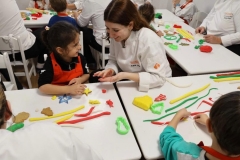
SCHOOL OF APPLIED MANAGEMENT SCIENCES
Gastronomy and Culinary Arts Program
CLM 102 | Course Introduction and Application Information
| Course Name |
Principles of Nutrition and Menu Planning
|
|
Code
|
Semester
|
Theory
(hour/week) |
Application/Lab
(hour/week) |
Local Credits
|
ECTS
|
|
CLM 102
|
Spring
|
3
|
0
|
3
|
6
|
| Prerequisites |
None
|
|||||
| Course Language |
English
|
|||||
| Course Type |
Required
|
|||||
| Course Level |
First Cycle
|
|||||
| Mode of Delivery | Online | |||||
| Teaching Methods and Techniques of the Course | DiscussionLecture / Presentation | |||||
| Course Coordinator | - | |||||
| Course Lecturer(s) | ||||||
| Assistant(s) | - | |||||
| Course Objectives | The aims of the course are; to develop theoretical knowledge about nutrition, to learn about nutrients and the various functions of nutrients, to understand the processes of digestion, absorption, transport and metabolism, to learn about food labeling, including mandatory nutrition labeling, serving sizes, descriptive terms, health claims and ingredient labeling, to understand the Dietary Reference Intakes, Daily Values for Food Labels and the Food Pyramid in food planning, to learn about information on food groups and exchange lists in menu planning, identify the factors affecting menu planning, types and patterns of menus, the principles and steps of menu planning, menu controlling and evaluation. |
| Learning Outcomes |
The students who succeeded in this course;
|
| Course Description | Healthy nutrition, planning of a healthy diet, nutrition labels, digestion, absorption and transport, the carbohydrates, lipids, proteins,metabolism, energy balance, body composition, weight management, vitamins, antioxidants, water ,and major minerals, trace minerals, diet and health, the factors that affect menu planning, developing menus, menu types, menu planning and its relation with nutrition, standard recipe development, yield testing process, designing, writing, and evaluation of a menu, menu characteristics, menu and food service equipment analysis. |
|
|
Core Courses | |
| Major Area Courses |
X
|
|
| Supportive Courses | ||
| Media and Management Skills Courses | ||
| Transferable Skill Courses |
WEEKLY SUBJECTS AND RELATED PREPARATION STUDIES
| Week | Subjects | Related Preparation |
| 1 | Introduction | |
| 2 | Food Choices and Human Health | Frances Sizer, Ellie Whitney, Nutrition Concepts and Controversies, Cengage Learning, 2016 Chapter 1: Food Choıces and Human Health (1-30) |
| 3 | Nutrition Tools-Standards and Guidelines | Frances Sizer, Ellie Whitney, Nutrition Concepts and Controversies, Cengage Learning, 2016 Chapter 1: Nutrition Tools-Standards and Guidelines (32-59) |
| 4 | Carbonhydrates | Karen Eich Drummond, Lisa M. Brefere-Nutrition for Foodservice and Culinary Professionals-John Wiley and Sons (2009) Chapter 3: Carbohydrates (81-119) |
| 5 | Lipids | Karen Eich Drummond, Lisa M. Brefere-Nutrition for Foodservice and Culinary Professionals-John Wiley and Sons (2009) Chapter 4: Lipids, Fats and Oils (125-160) |
| 6 | Proteins | Karen Eich Drummond, Lisa M. Brefere-Nutrition for Foodservice and Culinary Professionals-John Wiley and Sons (2009) Chapter 5: Protein (161-185) |
| 7 | Vitamins & Minerals | Karen Eich Drummond, Lisa M. Brefere-Nutrition for Foodservice and Culinary Professionals-John Wiley and Sons (2009) Chapter 6: Vitamins (187-220) |
| 8 | Water and other liquids / Midterm | Karen Eich Drummond, Lisa M. Brefere-Nutrition for Foodservice and Culinary Professionals-John Wiley and Sons (2009) Chapter 7: Water and Minerals (225 – 229) |
| 9 | Digestion, Metabolism and Interactions of Nutrition with Other Systems | Frances Sizer, Ellie Whitney, Nutrition Concepts and Controversies, Cengage Learning, 2016 Chapter 3: The Remarkable Body (71-98) |
| 10 | Oksidants, antioksidants, bioactive compounds and residuals | Karen Eich Drummond, Lisa M. Brefere-Nutrition for Foodservice and Culinary Professionals-John Wiley and Sons (2009) Chapter 11: Nutrition and Health (391 – 425) |
| 11 | Healthy Menu and Recipe Development | Karen Eich Drummond, Lisa M. Brefere-Nutrition for Foodservice and Culinary Professionals-John Wiley and Sons (2009) Chapter 9: Healthy Menus and Recipes (295 – 335) |
| 12 | Marketing of Healthy Menus | Karen Eich Drummond, Lisa M. Brefere-Nutrition for Foodservice and Culinary Professionals-John Wiley and Sons (2009) Chapter 10: Marketing to Health-Conscious Guests (355 – 382) |
| 13 | Hunger and Future of Food | Frances Sizer, Ellie Whitney, Nutrition Concepts and Controversies, Cengage Learning, 2016 Chapter 15: Hunger and Future of the Food (600-615) |
| 14 | Project Presentations | Karen Eich Drummond, Lisa M. Brefere-Nutrition for Foodservice and Culinary Professionals-John Wiley and Sons (2009) Chapter 13: Nutrition over the lifecycle (459-507) |
| 15 | Review of the Semester | |
| 16 | Final Exam |
| Course Notes/Textbooks | Karen Eich Drummond, Lisa M. Brefere-Nutrition for Foodservice and Culinary Professionals-John Wiley and Sons Frances Sizer, Ellie Whitney, Nutrition Concepts and Controversies, Cengage Learning, 2016 (ISBN 978‐0‐1239‐1882‐6) |
| Suggested Readings/Materials |
EVALUATION SYSTEM
| Semester Activities | Number | Weigthing |
| Participation |
1
|
10
|
| Laboratory / Application | ||
| Field Work | ||
| Quizzes / Studio Critiques |
2
|
20
|
| Portfolio | ||
| Homework / Assignments | ||
| Presentation / Jury | ||
| Project | ||
| Seminar / Workshop | ||
| Oral Exams | ||
| Midterm |
1
|
30
|
| Final Exam |
1
|
40
|
| Total |
| Weighting of Semester Activities on the Final Grade |
4
|
60
|
| Weighting of End-of-Semester Activities on the Final Grade |
1
|
40
|
| Total |
ECTS / WORKLOAD TABLE
| Semester Activities | Number | Duration (Hours) | Workload |
|---|---|---|---|
| Theoretical Course Hours (Including exam week: 16 x total hours) |
16
|
3
|
48
|
| Laboratory / Application Hours (Including exam week: '.16.' x total hours) |
16
|
0
|
|
| Study Hours Out of Class |
14
|
3
|
42
|
| Field Work |
0
|
||
| Quizzes / Studio Critiques |
2
|
15
|
30
|
| Portfolio |
0
|
||
| Homework / Assignments |
0
|
||
| Presentation / Jury |
0
|
||
| Project |
0
|
||
| Seminar / Workshop |
0
|
||
| Oral Exam |
0
|
||
| Midterms |
1
|
25
|
25
|
| Final Exam |
1
|
35
|
35
|
| Total |
180
|
COURSE LEARNING OUTCOMES AND PROGRAM QUALIFICATIONS RELATIONSHIP
|
#
|
Program Competencies/Outcomes |
* Contribution Level
|
||||
|
1
|
2
|
3
|
4
|
5
|
||
| 1 | Successfully applies theoretical and practical knowledge and skills in Gastronomy and Culinary Arts |
X | ||||
| 2 | Carries best practices in terms of work and food security, safety and hygiene in food production |
|||||
| 3 | Appreciates, evaluates and makes decisions regarding to visual, textual and nutritional data with respect to food production and presentation |
X | ||||
| 4 | Recognizes and evaluates the impact of gastronomy on culture and society |
|||||
| 5 | Assumes responsibility for solving complex problems that may occur in the field of Gastronomy and Culinary Arts, both individually and as a team member |
X | ||||
| 6 | Evaluates the knowledge and skills acquired in the field of Gastronomy and Culinary Arts with a critical approach and effectively communicate their ideas and suggestions for solutions in written and oral form. |
X | ||||
| 7 | Possesses necessary knowledge and skills in relevant fields such as gastronomy, design, law and management and effectively apply them to the practice of Culinary Arts |
|||||
| 8 | Uses the technological tools related to Gastronomy and Culinary Arts effectively |
|||||
| 9 | Updates and improve the knowledge, skills and competencies related to Gastronomy and Culinary Arts with lifelong learning awareness and sustainability with an ethical approach |
X | ||||
| 10 | Collects data in the areas of Gastronomy and Culinary Arts and communicate with colleagues in a foreign language. (European Language Portfolio Global Scale”, Level B1) |
|||||
| 11 | Speaks a second foreign at a medium level of fluency efficiently |
|||||
| 12 | Relates the knowledge gained through the history of humanity to the field of expertise |
|||||
*1 Lowest, 2 Low, 3 Average, 4 High, 5 Highest
NEWS |ALL NEWS

Aegean flavors from the chefs of the future
Izmir University of Economics (IUE) Department of Gastronomy and Culinary Arts left its mark on the 6th Izmir GastroFest, organized this year with
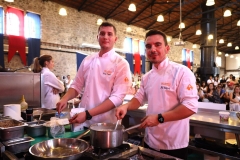
They added flavor to GURMEFEST
GURMEFEST, one of the biggest food, drink and entertainment festivals of Izmir, was ‘flavored’ with the dishes prepared and presented by the
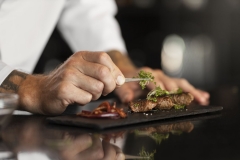
“Izmir and Bodrum will class up”
The MICHELIN Guide, one of the most prestigious restaurant rating systems in the world, has added Izmir and Bodrum to its Turkish
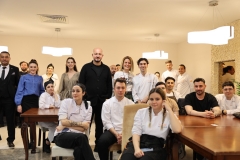
IUE graduates will prepare the flavors unique to Turkish cuisine
Bilsev Group, who is preparing to expand to Dubai this year with its Ferdi Baba, Fabrice Restaurant and Baba Pizza brands, will
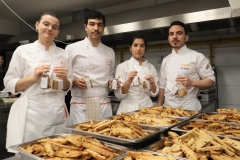
They prepared products that are filling and have a long shelf life
25 students of Department of Gastronomy and Culinary Arts of Izmir University of Economics (IUE) prepared products with a long shelf life,




